Consultative selling: process and examples
Jun 29th, 2023

Contents
What is consultative selling?
Consultative selling process
Example of a consultative selling approach
Nowadays, customers have greater access to information than ever before. Consumers can easily research the product, analyze reviews, and find and compare alternative offerings. As a result, salespeople now engage with prospective clients much later in the sales process than they did in past decades. For this reason, a salesperson must satisfy the requirements of a prospective customer at the right point in the buyer’s journey.
A salesperson should take into account clients’ needs and demonstrate a willingness to help them solve their problems. In this case, consultative selling is the best solution as this sales approach aims to earn customers’ trust. Instead of being pushy and promoting a product, sales reps engage the client in the decision-making process and demonstrate empathy. In this article, we'll explain consultative selling and describe how to incorporate it into your sales strategy so that you can win over customers and increase sales.
What is consultative selling?
Consultative selling or needs-based selling is a strategy focusing mainly on the customer instead of a product or service to determine consumer requirements and provide solutions. This sales approach relies on building trusting relationships with customers. Consultative sales representatives learn about clients’ needs, ask questions and then tailor the offering to meet those demands. With this method, salespeople can better understand the challenges encountered by customers and position a product more compellingly.
Salespeople who use this approach behave more like advisers than sales reps. Instead of promoting a particular product, sales representatives provide prospective clients with various options based on their pain points. However, consultative selling does not work in every situation. It is suitable when customers have already researched the products but are still determining which one is best for them.
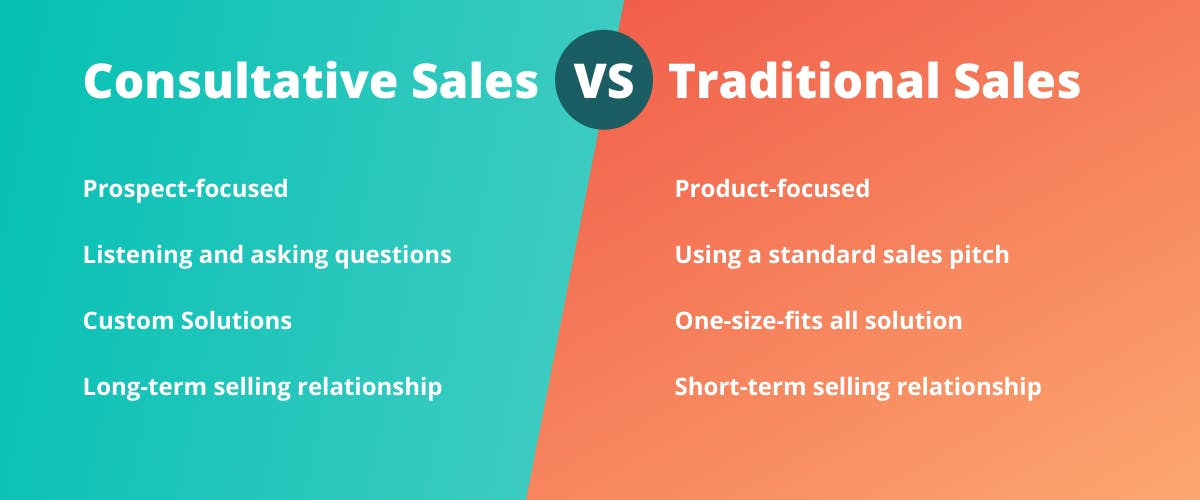
In this case, the first contact with the customer typically happens in the middle of the sales funnel. Since consumers conduct their research by studying product information and reading reviews, it becomes more challenging for salespeople to manage customer conversations. By using this approach, sales reps can easily establish contact with customers at any point in the buyer’s journey and make sure that communication benefits both parties.
Consultative selling brings good results if salespeople pay attention to consumers’ pain points by asking open-ended questions, actively listening to customers, providing solutions instead of advertising products or features, and offering useful information without expecting anything in return. Thus, the main principle of consultative selling is to care more about customers than about earning money. Although this idea seems somewhat radical in a modern business world where profit drives most decisions, it is a win-win partnership both for the buyer and the seller.
Now we will compare consultative selling and other sales strategies to understand the differences and learn about the advantages and disadvantages of those techniques.
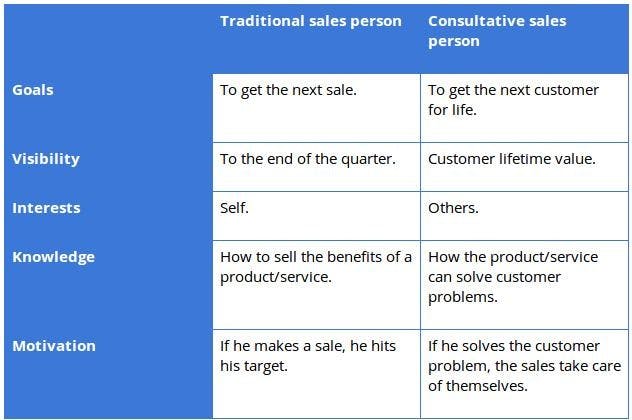
Consultative selling vs solution selling
Consultative and solution selling are similar approaches as both place more emphasis on a customer’s requirements. However, instead of talking about the product’s features and benefits, solution selling addresses the consumer’s problem and sells the result rather than the means to achieve it.
The most significant differences between these approaches are as follows. While solution selling is more product-driven and focused on sales, consultative selling is process-driven and prioritizes customer success. Sales reps practicing solution selling often push their own company’s products to meet customers’ requirements. They consider customer needs and adjust their sales pitch to these demands. At the same time, consultative selling helps consumers reach a sales decision only if appropriate by providing clients with the tools they require to understand the issue and find the solution. Therefore, solution selling is built on authority and expertise, while consultative selling is built on trust.
If your product has a complex purchasing process, various pricing options, and many add-ons, a solution selling will be particularly effective. Consultative selling will be a great option in the B2B market, where the buyers already have information about the product and well-defined requirements.
Consultative selling vs value-based selling
Value-based selling emphasizes measurable benefits a product or service provides to a client. The values cover factors influencing a company’s profitability, such as cost savings and productivity. Sales representatives who follow this approach explain to customers how a product or service can help them address a problem. Besides, salespeople often use value-based selling to justify pricing, as products that provide better value can be sold for a higher price.
In value-based selling, sales reps focus on how clients can profit from a product or solution. First, salespeople identify prospects’ objectives and challenges. Then they take actual data like typical ROI from existing clients to demonstrate the positive impact of using the product. Consultative selling, in contrast, highlights both measurable and non-measurable outcomes to persuade the consumer.
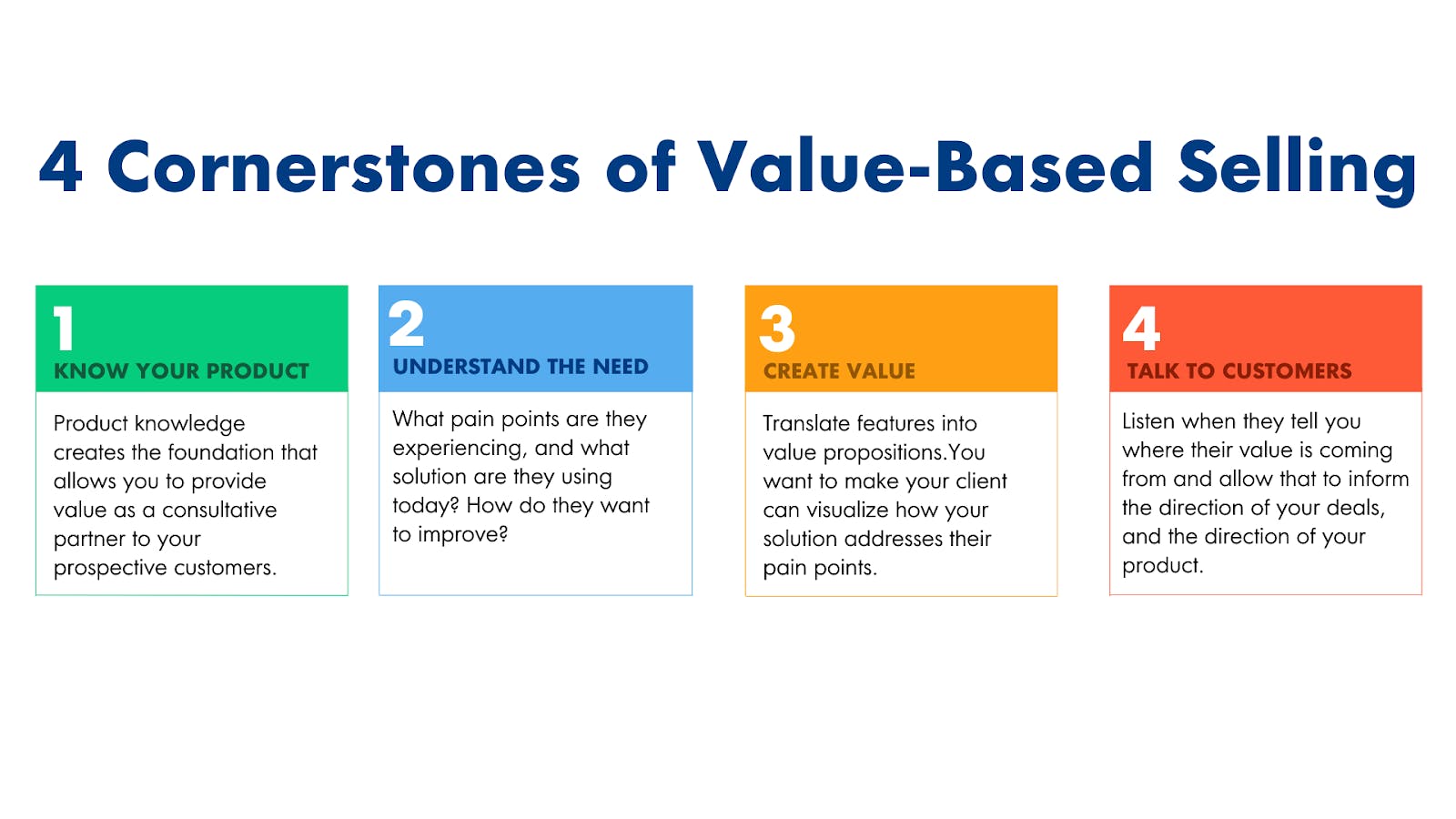
While value-based selling can be effective in some situations, it frequently results in pricing wars with rivals, particularly when sales representatives are unable to offer significant quantifiable results to differentiate themselves from the competition. Conversely, consultative selling implies a broader strategy that places greater emphasis on the customer's success and earnings instead of the product’s price.
Consultative selling vs transactional selling
Transactional selling is a sales approach that focuses mainly on closing a deal without paying much attention to understanding customers’ problems and how the product can solve these issues. The strategy’s primary objective is to make the largest possible number of sales. In transactional selling, a salesperson contacts the client first by making a phone call or hosting an online meeting or webinar. Transactional selling entails actions like prospecting, building relationships with clients, delivering a sales pitch, and making a sale.
In this sales methodology, establishing an emotional connection is less essential than closing a deal. Sales representatives often employ scarcity techniques to create a feeling of urgency. As a result, customers move faster through the sales funnel. In addition, transactional sales are driven by price and incentives rather than personalizing a message and offering a solution that addresses the client’s pain point.
On the other hand, consultative selling is a long-term process that emphasizes a longer sales cycle. Consultative salespeople aim to establish long-lasting relationships with customers instead of making a quick sale. It makes no difference who initiates the conversation in consultative selling. The goal of the interactions is to create and maintain a positive connection with the client to increase revenue.
Transactional selling is a suitable sales strategy for businesses that do not rely on repeat purchases in retail, e-commerce, real estate, or automotive industries. The objective of this approach is to sell a product to one client without necessarily expecting a customer to make another purchase in the future. In contrast, consultative selling will be a great choice if your goal is to build brand loyalty and provide long-term solutions to clients.
Once you are familiar with different sales strategies, you can decide which approach will best fit your business. If you opt for the consultative selling method, keep reading to discover how to implement this approach for your company step-by-step.
Consultative selling process
The consultative selling process typically includes six steps: market research, asking questions, active listening, educating prospects, qualifying the lead, and closing the deal. We will discuss each of these steps in more detail below.
Research
The first step of the consultative selling process is to learn as much information about your leads as possible before talking to them. At this phase, your task is to collect data concerning your potential customer’s revenue model, main competitors, the industry’s growth rate, and problems similar companies are trying to solve. Check social media, LinkedIn, and the company’s website. The greater the amount of gathered information, the higher the chances of closing the deal.
The other crucial information about your leads includes the size of the business, website pages viewed, email preferences, and social media usage. Besides that, you should pay attention to the specific type of content that your lead is most interested in.
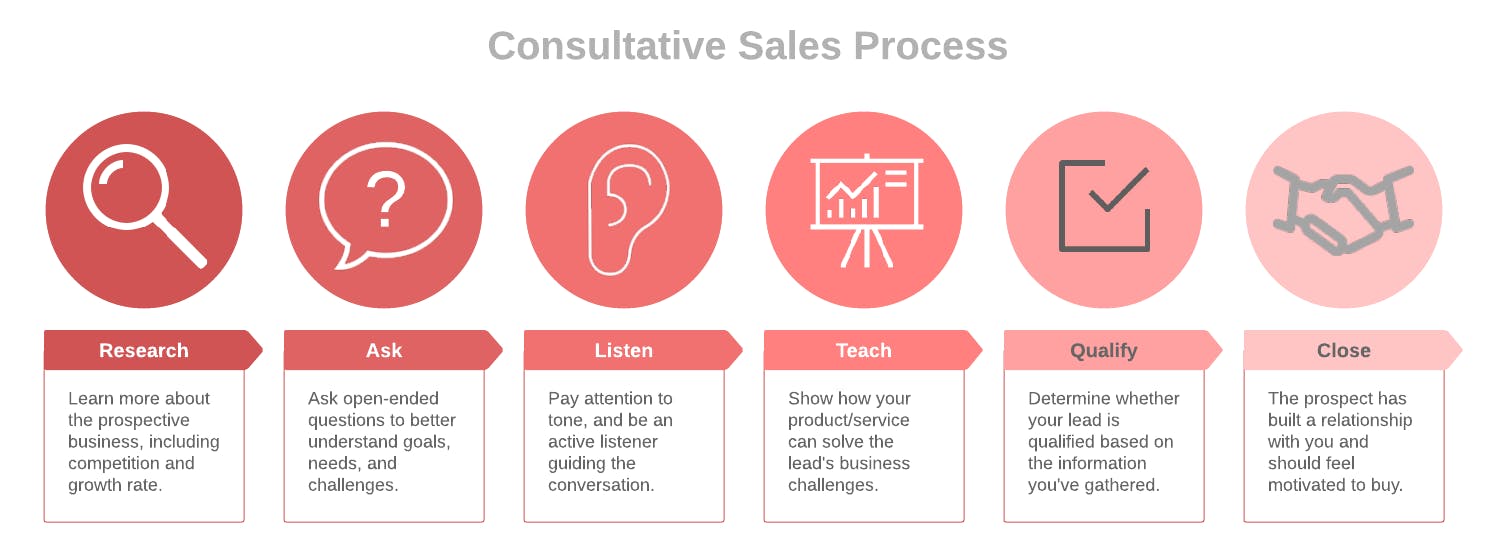
Ask questions
Although you have collected a lot of information about your client, you still have to ask questions to encourage dialogue instead of making a presentation. The idea is to let the lead provide the information on their initiative. It's crucial to avoid making any judgments about the prospect's responses to build trust. You aim to establish open and transparent communication and nurture a relationship that will last long after completing the deal.
Ask open-ended questions that start with the words what, who, where, why, when, and how. Avoid asking questions that lead to yes or no answers. They often start with the words can, do, and are. The potential customer’s answers will help you discover their goals, challenges, and time frames needed to achieve these objectives. Questions will also allow you to uncover the lead’s level of authority and budget.
Practice active listening
Stay focused on the lead’s answers and keep your mind off of how you would respond to what is being told. Then repeat back the client’s words after they have finished speaking. You can describe what you think has been said in your terms, clarify the information by asking questions and summarize the main points. It demonstrates that you paid attention to what they were saying and correctly grasped their message.
Notice the tone, hesitancy, and quick responses. These are all hints to what matters the most to your prospect. In addition, make sure that a potential client is talking 80% of the time at the beginning of the conversation.
Take notes on everything the speaker says. You can use specific applications to record Zoom calls or AI note-taking programs like Fathom. The main takeaway is to prepare yourself for the possibility that you won't understand everything during the initial discussion. Your notes will help you analyze the answers and identify the client’s needs and pain points.
Educate your prospects
At this stage of the sales process, you already know your prospects’ problems and understand how your solution can help them. Even though you may have a standard sales pitch template, you should tailor your presentation to potential customers’ needs and goals. Use your pitch to offer a clear solution that includes explicit instructions in addition to the product. You'll become not just a mentor but also a company savior by showing your potential partners how to create a strategy to handle their problems.
First, educate your prospects about the actual consequences of their challenges, such as the financial impact on their business. For example, if they have problems with productivity, demonstrate to potential customers how the wasted time turns into a financial loss for the company.
Then educate them about the underlying reasons for their problems. For instance, a sales manager might believe that his team’s poor performance is due to the CRM. This may be partially true, but a proactive sales representative may look further and discover that the existing CRM is replete with inaccurate data. Finally, provide them with possible solutions to the problem.
When it comes to signing the contract, providing answers will increase the level of confidence in your partnership and encourage loyalty. Plus, by taking time to listen to the prospect’s needs and resolving concerns, you will create a trusting atmosphere.
Qualify the lead
Although one of the goals of consultative selling is to build relationships with clients, your primary objective is to sell the product. Therefore, you need to identify the leads who are the right fit for your business. The characteristics of a qualified lead are goals, challenges, a clear plan, a set timeline, and a budget.
You need to identify a prospect who is not a good match for your product or service as soon as possible. Don’t try to sell to unqualified leads just because you have already invested a lot of time. Instead, what you should be doing is giving your undivided attention to qualified prospects.
Close the deal
If you have collected enough information, listened to, educated and qualified leads, it would be easy to complete a deal. Your prospects have created a relationship with you, they have a set budget and the authority to make a purchase, and they are motivated to find a quick and effective solution for their issue.
Keep going, and don't underestimate your efforts if you face resistance from prospects. Ask them instead how they plan to achieve their company objectives without your assistance. Focus on meeting their requirements, and look at everything from a long-term perspective. Your lead retention rate will be higher if you consistently work to close only those leads that are a good match for your company.
The consultative sales strategy is based on a genuine interest in your clients as well as knowledge of your target market and offering. Utilize the tips above to develop your own approach and improve your selling techniques with a consultative strategy.
Example of a consultative selling approach
Now we will provide an example of a consultative selling approach to demonstrate how it works in practice. Let us look at the typical buying cycle and the actions that the salesperson should take.
Stage 1. Problem recognition
A company identifies a business problem and wants to invest in CRM. The potential customer, possibly a customer service manager, operations director, or chief operating officer, conducts a study to learn what makes an effective CRM and what a business should look for.
Stage 2. Information search
A prospect contacts a company via email, phone, contact form, or other means. Potential customer evaluates the issue’s priority and establishes criteria and a decision procedure. Then, a salesperson asks specific questions to understand consumers’ needs and learn more about their current software package or operating system.
A salesperson can help a prospect decide by offering a phone call, sending how-to blog pieces, or other relevant articles. A sales representative can also send case studies outlining how they helped other companies address a similar problem.
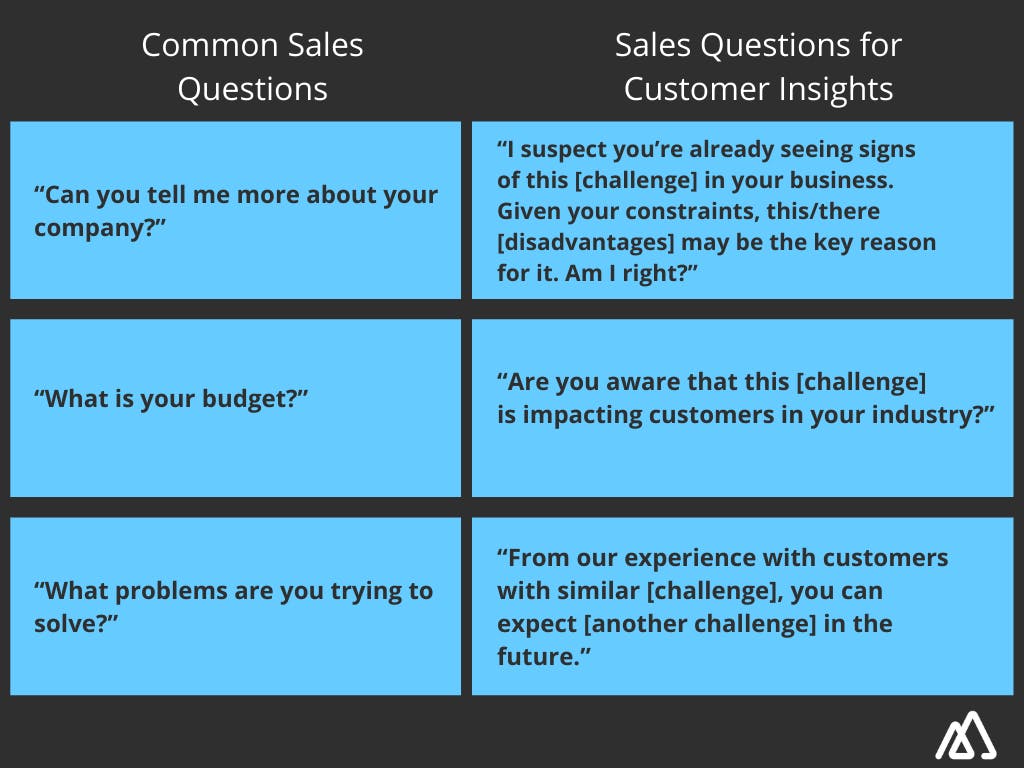
Stage 3. Evaluation of alternatives
Customers conduct research, evaluate options, reduce choices, and refine their decision-making standards. While it's crucial to inform the potential customer about the various options and solutions, you should be bold in highlighting the advantages and features of your product or service.
Since your client will be comparing the components of your service to those of the competitors, you should include some information about the benefits of your product in your sales pitch. Customers may find it too difficult to compare your product to competitors’ solutions if they are unclear about the characteristics of your offering.
Stage 4. Decision
Then you apply your knowledge to develop a strategy, make recommendations, and help the client select the best option for their company and its growth. If you discover that prospect is unqualified, you can offer an alternative that better fits their requirements or price.
Stage 5. Purchase
A customer makes a purchase. Sales representatives help with follow-up and implementation and provide additional information and tools that can be useful for the client. At this point, it's critical to provide your customer with the support they require.
Stage 6. Post-purchase evaluation
During the post-purchase stage, the customer assesses results and compares performance to the sales promise. A salesperson needs to talk about outcomes, analyze notes made during customer calls, and collect feedback to use in upcoming conversations. It's a fantastic chance to learn and build a long-lasting relationship with the customer.
In conclusion, the consultative sales method is, without a doubt, the best strategy for B2B SaaS companies. Keep in mind that your responsibility as a salesperson is to help your prospects reach their objectives and make informed decisions. Focus on providing and developing a strong connection with customers so that they feel supported and acknowledged and have a great sales experience.
